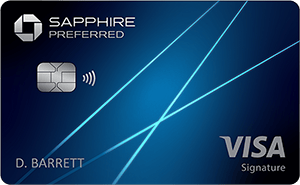Chase Sapphire Preferred vs. Sapphire Reserve: Reserve Dethroned
For casual and heavy travelers alike, the Chase Sapphire Preferred is a better all-around package.

Many or all of the products on this page are from partners who compensate us when you click to or take an action on their website, but this does not influence our evaluations or ratings. Our opinions are our own.
For frequent travelers, the Chase Sapphire Reserve® packs plenty of value with its high rewards rate, top-notch benefits and welcome offer, even with its annual fee of $795. The card debuted in 2016 to much fanfare; Chase even ran out of the metal credit cards when supply couldn’t keep up with demand.
For years, the Chase Sapphire Reserve® was actually a surprisingly more cost-effective choice than its $95-annual-fee sibling, the Chase Sapphire Preferred® Card. That’s because the card’s generous credits and perks outweighed the fee for many.
But now — thanks to a refresh of the Chase Sapphire Preferred® Card and a major overhaul of the Chase Sapphire Reserve® that included an annual fee increase (it jumped from $450 to $550 in 2020 and then to $795 in 2025) — the Chase Sapphire Preferred® Card emerges the victor for many cardholders.
Here’s why there's a new winner.
on Chase's website
on Chase's website
Earn 75,000 bonus points after you spend $5,000 on purchases in the first 3 months from account opening.
Earn 125,000 bonus points after you spend $6,000 on purchases in the first 3 months from account opening.
5 points per $1 spent on all travel booked through Chase.
3 points per $1 spent on dining (including eligible delivery services and takeout).
3 points per $1 spent on select streaming services.
3 points per $1 spent on online grocery purchases (not including Target, Walmart and wholesale clubs).
2 points per $1 spent on travel not booked through Chase.
1 point per $1 spent on other purchases.
Through September 2027: 5 points per $1 spent on Lyft.
8 points per $1 spent on travel bookings purchased through Chase's travel portal, including flights, hotels, rental cars, cruises, activities and tours.
4 points per $1 spent on bookings made directly with an airline or hotel.
3 points per $1 spent at restaurants, including eligible food delivery.
1 point per $1 spent on all other purchases.
Through Sept. 2027: 5 points per $1 spent on Lyft (plus a $10 monthly Lyft credit).
A $50 annual credit on hotel stays booked through Chase.
Each account anniversary, cardmembers will earn bonus points equal to 10% of total purchases made the previous year.
1:1 transfer partners, including United, Southwest, JetBlue, Marriott and Hyatt.
$300 annual credit, automatically applied to travel spending.
1:1 transfer partners (same as the Chase Sapphire Preferred® Card).
Access to more than 1,000 airport lounges worldwide through Priority Pass Select.
Application credit every four years for TSA PreCheck, Global Entry or NEXUS application fees charged to your card.
Access to “Reserved by Sapphire” restaurant-booking feature.
Up to $500 in credit for The Edit, Chase’s high-end hotel portal, in the form of two $250 credits a year.
Up to $300 in credit at restaurants in the Sapphire Reserve Exclusive Tables program. You get this as two separate credits of $150 in each half of the year.
Up to $300 in statement credit for StubHub, in the form of two $150 credits a year.
Up to $250 toward Apple TV+ and Apple Music subscriptions.
Up to $120 in credit toward Peloton membership, available at $10 a month. Plus you earn 10 points per dollar on eligible Peloton purchases.
Complimentary IHG One Rewards Platinum Elite Status through Dec. 31, 2027.
If you spend $75,000 or more on the card each year, you’ll also get a $500 credit for Southwest Airlines flights booked through Chase, Southwest A-List status, IHG One Rewards Diamond Elite Status and a $250 credit for purchases through The Shops at Chase.
Why the Chase Sapphire Preferred® Card wins for most
More rewarding across a broader swath of spending, with a kicker
While the Chase Sapphire Reserve® boasts a few eye-popping reward rates (largely for spending through Chase), the Chase Sapphire Preferred® Card earns more for popular everyday spending categories:
3 points per $1 spent on dining (including eligible delivery services and takeout).
3 points per $1 spent on select streaming services.
3 points per $1 spent on online grocery purchases (not including Target, Walmart and wholesale clubs).
The Chase Sapphire Reserve® earns the same 3 points per $1 spent on most dining, but all streaming and grocery purchases will earn just 1 point per $1 spent.
The Chase Sapphire Preferred® Card also offers an interesting and potentially lucrative anniversary bonus each year that isn't found on the Chase Sapphire Reserve®. Each account anniversary, cardmembers will earn bonus points equal to 10% of total purchases made the previous year. That means $25,000 in spending will earn an additional 2,500 bonus points.
Adding authorized users won't cost anything
The Chase Sapphire Reserve® charges a $195 annual fee for each authorized user you add to the account. This isn’t unusual for luxury cards, but it changes the math if you’re looking to share the account with one or more people.
The Chase Sapphire Preferred® Card doesn’t charge for adding authorized users.
Lower annual fee
If you're unsure whether you'll use most of the benefits or credits that come with the Chase Sapphire Reserve®, or you know you won't, it simply isn't worth the $795 annual fee — despite its superior ongoing rewards. The Chase Sapphire Preferred® Card will likely be a more cost-effective option, especially because it has the same 1:1 transfer partners as the Chase Sapphire Reserve®, a generous welcome offer, and an annual fee that is a staggering $700 cheaper than its counterpart.
Nerdy Perspective
Preferred or Reserve?
Why you might want the Chase Sapphire Reserve® instead
$300 annual travel credit
Chase automatically applies this credit to any travel purchases you make with your card — including airlines, hotels, timeshares, campground fees and ferries, among other categories — effectively canceling out a large portion of its annual fee.
Once you factor in the $300 easy-to-use credit, the Chase Sapphire Reserve® has an effective annual fee of $495. Still not cheap, but more palatable, and that's before factoring in the card's plethora of perks and additional benefits.
Lounge access and other top-tier benefits
With the Chase Sapphire Reserve®, you get Priority Pass Select access to more than 1,000 airport lounges worldwide. That means you can relax in a comfy armchair before your flight and take advantage of free snacks and drinks. Chase Sapphire Reserve® cardholders also have access to Chase's Sapphire Lounge locations in select airports.
The card offers reimbursement every four years for the application fee Global Entry, TSA PreCheck or NEXUS, which can let you sail through customs or security lines on your next trip.
The Chase Sapphire Reserve® also comes with yearly credits from various travel, dining and shopping merchants that add up to thousands of dollars in value per year. While these credits can help chip away at the annual fee, keeping track of and using them will require work and won’t be worth it for some cardholders.
The Chase Sapphire Preferred® Card lacks these travel perks.
Points are potentially worth more for travel through Chase
Both cards offer rewards with plenty of versatility, allowing you to transfer points to some airlines and hotels — such as British Airways, United and Hyatt — at a 1:1 ratio:
Plus, prior to the sweeping changes Chase made to its redemption policy in 2025, if you booked travel through Chase you’d earn 1.5 cents per point on the Chase Sapphire Reserve® — compared with 1.25 cents per point on the Chase Sapphire Preferred® Card. This still applies for customers who had the Chase Sapphire Reserve® or applied for it before June 23, 2025. Those cardholders can continue to redeem their points earned before Oct. 26, 2025, at the prior 1.5 cents per point, until Oct. 26, 2027.
However, if you apply for the Chase Sapphire Reserve® on or after June 23, 2025, you can redeem points for up to 2 cents apiece only on rotating flights and hotel stay offers with Chase’s new Points Boost redemption feature. All other point redemptions for travel via Chase that are not eligible for Points Boost are worth 1 cent each. The Points Boost system will take full effect for all cardholders beginning Oct. 26, 2027.
Note that the Points Boost redemption system also applies to the Chase Sapphire Preferred® Card, and it'll phase in similarly. For new cardholders, points earned with the card are worth up to 1.5 cents each for hotels and flights with select airlines, and up to 1.75 cents each for premium cabin tickets on select airlines booked through Chase. On all bookings not eligible for Points Boost, you get a value of 1 cent per point.
Which card should you get?
With its generous welcome bonus, solid rewards in many everyday spending categories, anniversary bonus rebate, $50 annual hotel credit and double-digit annual fee, the Chase Sapphire Preferred® Card packs a powerful punch, even for frequent travelers.
That said, for those who spend frequently through Chase, value benefits like lounge access, and would make use of its “coupon book”-style credits, the long-term winner could be the Chase Sapphire Reserve®.
1x-8x
Points125,000
Points1x-5x
Points75,000
Points1x-8x
Points200,000
PointsFind the right credit card for you.
Whether you want to pay less interest or earn more rewards, the right card's out there. Just answer a few questions and we'll narrow the search for you.









